Abstract
Soluble glutamine synthetase activity (L-glutamate:ammonia ligase, ADP forming, EC 6.3.1.2) was purified to electrophoretic homogeneity from the filamentous non-N2-fixing cyanobacterium Phormidium laminosum (OH-1-p.Cl1) by using conventional purification procedures in the absence of stabilizing ligands. The pure enzyme showed a specific activity of 152 mumol of gamma-glutamylhydroxamate formed.min-1 (transferase activity), which corresponded to 4.4 mumol of Pi released.min-1 (biosynthetic activity). The relative molecular mass of the native enzyme was 602 kilodaltons and was composed of 12 identically sized subunits of 52 kilodaltons. Biosynthetic activity required the presence of Mg2+ as an essential activator, although Co2+ and Zn2+ were partially effective. The kinetics of activation by Mg2+, Co2+, and Zn2+ were sigmoidal, and concentrations required for half-maximal activity were 18 mM (h = 2.2), 6.3 mM (h = 5.6), and 6.3 mM (h = 2.45), respectively. However, transferase activity required Mn2+ (Ka = 3.5 microM), Cu2+, Co2+, or Mg2+ being less effective. The substrate affinities calculated for L-Glu, ammonium, ATP, L-Gln, and hydroxylamine were 15, 0.4, 1.9 (h = 0.75), 14, and 4.1 mM, respectively. Optimal pH and temperature were 7.2 and 55 degrees C for biosynthetic activity and 7.5 and 45 degrees C for transferase activity. The biosynthetic reaction mechanism proceeded according to an ordered three-reactant system, the binding order being ammonium, L-Glu, and ATP. The presence of Mn2+ or Mg2+ drastically affected the thermostability of transferase and biosynthetic activities. Heat inactivation of biosynthetic activity in the presence of Mn2+ obeyed first-order kinetics, with an Ea of 76.8 kcal (ca. 321 kJ) mol-1. Gly, L-Asp, L-Ala, L-Ser and, with lower efficiency, L-Lys and L-Met, L-Lys, and L-Glu inhibited only transferase activity. No cumulative inhibition was observed when mixtures of amino acids were used. Biosynthetic activity was inhibited by AMP (Ki= 7 mM), ADP (Ki= 2.3 mM), p-hydroxymercuribenzoate (Ki= 25 microM), and L-methionine-D, L-sulfoximine (Ki= 2 microM). The enzyme was not activated in vitro by chemically reduced Anabaena thioredoxin. This is the first report of glutamine synthetase activity purified from a filamentous non-N2-fixing cyanobacterium.
Full text
PDF
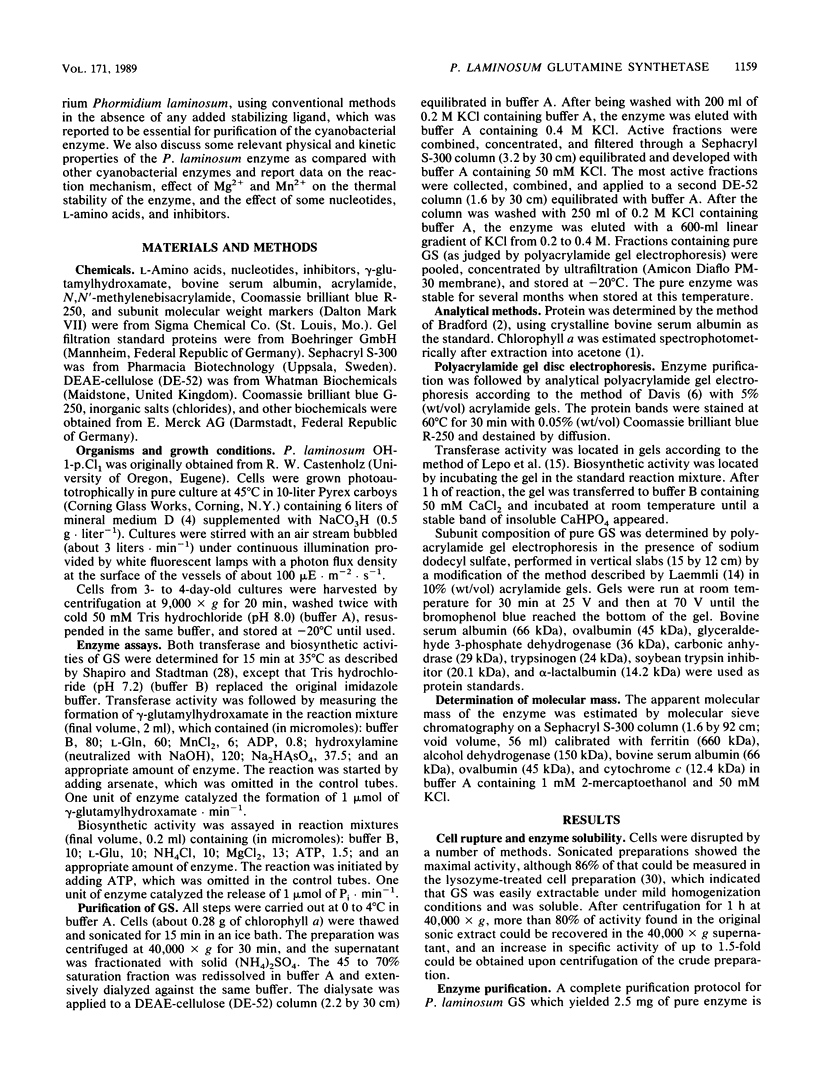
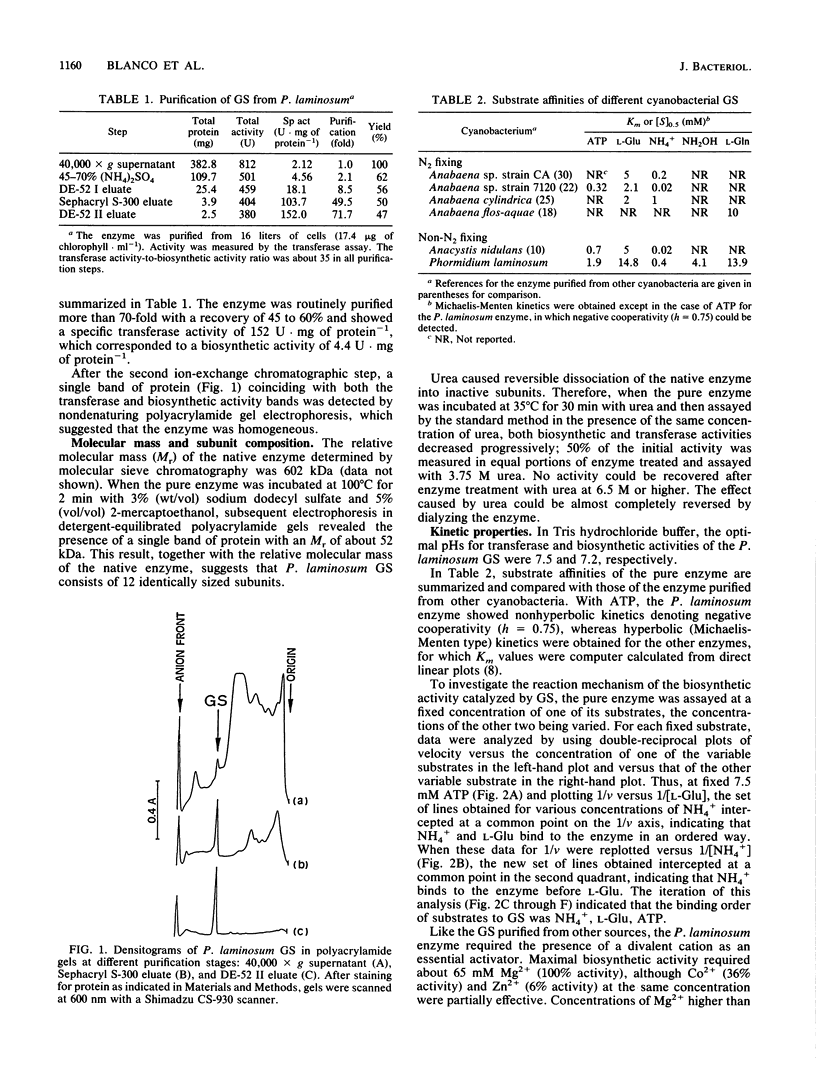
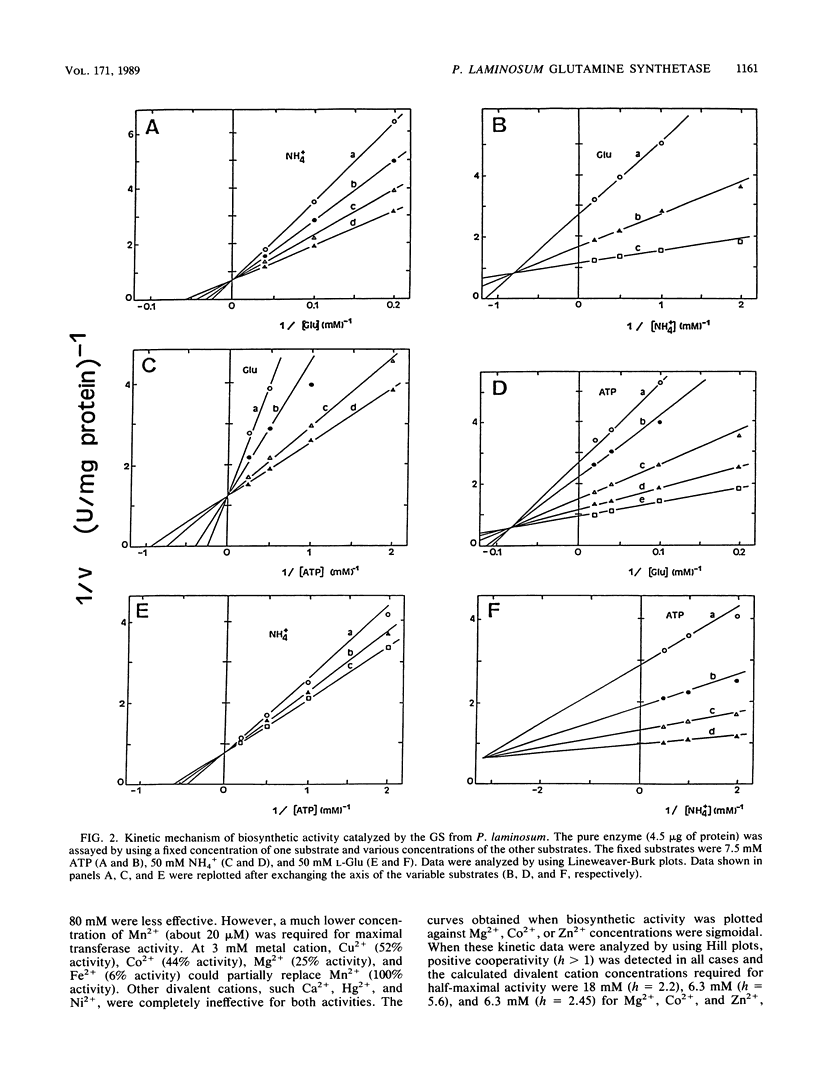
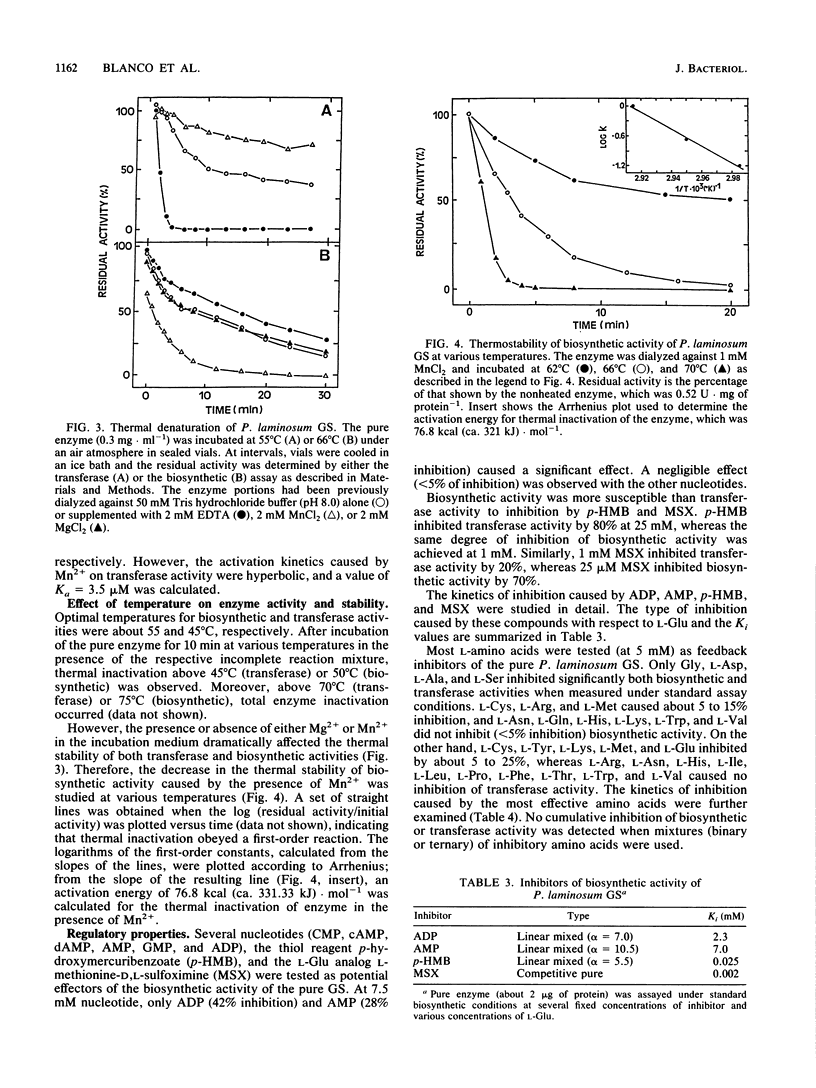
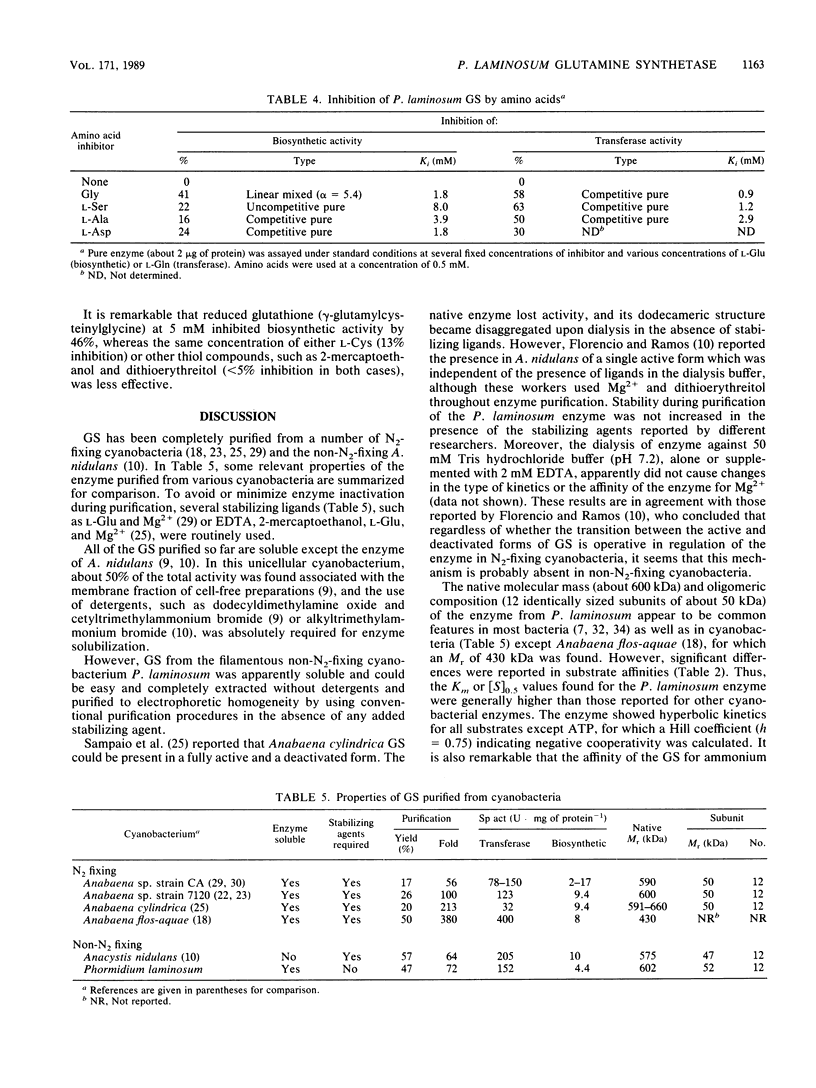
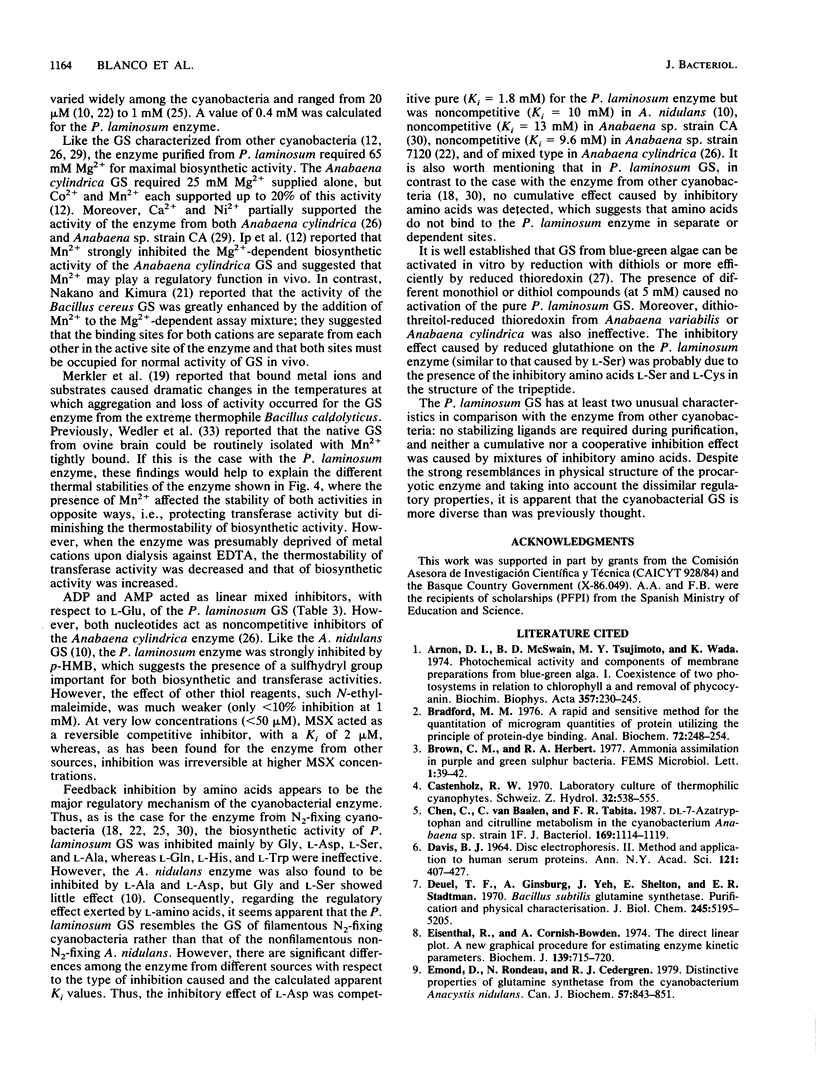

Selected References
These references are in PubMed. This may not be the complete list of references from this article.
- Arnon D. I., McSwain B. D., Tsujimoto H. Y., Wada K. Photochemical activity and components of membrane preparations from blue-green algae. I. Coexistence of two photosystems in relation to chlorophyll a and removal of phycocyanin. Biochim Biophys Acta. 1974 Aug 23;357(2):231–245. doi: 10.1016/0005-2728(74)90063-2. [DOI] [PubMed] [Google Scholar]
- Bradford M. M. A rapid and sensitive method for the quantitation of microgram quantities of protein utilizing the principle of protein-dye binding. Anal Biochem. 1976 May 7;72:248–254. doi: 10.1006/abio.1976.9999. [DOI] [PubMed] [Google Scholar]
- Chen C. H., Van Baalen C., Tabita F. R. DL-7-azatryptophan and citrulline metabolism in the cyanobacterium Anabaena sp. strain 1F. J Bacteriol. 1987 Mar;169(3):1114–1119. doi: 10.1128/jb.169.3.1114-1119.1987. [DOI] [PMC free article] [PubMed] [Google Scholar]
- DAVIS B. J. DISC ELECTROPHORESIS. II. METHOD AND APPLICATION TO HUMAN SERUM PROTEINS. Ann N Y Acad Sci. 1964 Dec 28;121:404–427. doi: 10.1111/j.1749-6632.1964.tb14213.x. [DOI] [PubMed] [Google Scholar]
- Deuel T. F., Ginsburg A., Yeh J., Shelton E., Stadtman E. R. Bacillus subtilis glutamine synthetase. Purification and physical characterization. J Biol Chem. 1970 Oct 25;245(20):5195–5205. [PubMed] [Google Scholar]
- Eisenthal R., Cornish-Bowden A. The direct linear plot. A new graphical procedure for estimating enzyme kinetic parameters. Biochem J. 1974 Jun;139(3):715–720. doi: 10.1042/bj1390715. [DOI] [PMC free article] [PubMed] [Google Scholar]
- Emond D., Rondeau N., Cedergren R. J. Distinctive properties of glutamine synthetase from the cyanobacterium Anacystis nidulans. Can J Biochem. 1979 Jun;57(6):843–851. doi: 10.1139/o79-104. [DOI] [PubMed] [Google Scholar]
- Ip S. M., Rowell P., Stewart W. D. The role of specific cations in regulation of cyanobacterial glutamine synthetase. Biochem Biophys Res Commun. 1983 Jul 18;114(1):206–213. doi: 10.1016/0006-291x(83)91614-5. [DOI] [PubMed] [Google Scholar]
- Johansson B. C., Gest H. Adenylylation/deadenylylation control of the glutamine synthetase of Rhodopseudomonas capsulata. Eur J Biochem. 1977 Dec 1;81(2):365–371. doi: 10.1111/j.1432-1033.1977.tb11960.x. [DOI] [PubMed] [Google Scholar]
- Laemmli U. K. Cleavage of structural proteins during the assembly of the head of bacteriophage T4. Nature. 1970 Aug 15;227(5259):680–685. doi: 10.1038/227680a0. [DOI] [PubMed] [Google Scholar]
- Lepo J. E., Stacey G., Wyss O., Tabita F. R. The purification of glutamine synthetase from Azotobacter and other procaryotes by blue sepharose chromatography. Biochim Biophys Acta. 1979 Jun 6;568(2):428–436. doi: 10.1016/0005-2744(79)90311-5. [DOI] [PubMed] [Google Scholar]
- Matsuoka K., Kurebayashi T., Kimura K. Regulation and properties of glutamine synthetase purified from Bacillus cereus. J Biochem. 1985 Nov;98(5):1211–1219. doi: 10.1093/oxfordjournals.jbchem.a135387. [DOI] [PubMed] [Google Scholar]
- McMaster B. J., Danton M. S., Storch T. A., Dunham V. L. Regulation of glutamine synthetase in the blue-green alga Anabaena flos-aquae. Biochem Biophys Res Commun. 1980 Sep 30;96(2):975–983. doi: 10.1016/0006-291x(80)91450-3. [DOI] [PubMed] [Google Scholar]
- Merkler D. J., Srikumar K., Marchese-Ragona S. P., Wedler F. C. Aggregation and thermo-inactivation of glutamine synthetase from an extreme thermophile, Bacillus caldolyticus. Biochim Biophys Acta. 1988 Jan 4;952(1):101–114. doi: 10.1016/0167-4838(88)90106-9. [DOI] [PubMed] [Google Scholar]
- Nagatani H., Shimizu M., Valentine R. C. The mechanism of ammonia assimilation in nitrogen fixing Bacteria. Arch Mikrobiol. 1971;79(2):164–175. doi: 10.1007/BF00424923. [DOI] [PubMed] [Google Scholar]
- Nakano Y., Kimura K. Independent bindings of Mn2+ and Mg2+ to the active site of B. cereus glutamine synthetase. Biochem Biophys Res Commun. 1987 Jan 30;142(2):475–482. doi: 10.1016/0006-291x(87)90299-3. [DOI] [PubMed] [Google Scholar]
- Orr J., Haselkorn R. Kinetic and inhibition studies of glutamine synthetase from the cyanobacterium Anabaena 7120. J Biol Chem. 1981 Dec 25;256(24):13099–13104. [PubMed] [Google Scholar]
- Orr J., Keefer L. M., Keim P., Nguyen T. D., Wellems T., Heinrikson R. L., Haselkorn R. Purification, physical characterization, and NH2-terminal sequence of glutamine synthetase from the cyanobacterium Anabaena 7120. J Biol Chem. 1981 Dec 25;256(24):13091–13098. [PubMed] [Google Scholar]
- Rowell P., Stewart W. D. Alanine dehydrogenase of the N2-fixing blue-green alga, Anabaena cylindrica. Arch Microbiol. 1975 Sep;107(2):115–124. doi: 10.1007/BF00446830. [DOI] [PubMed] [Google Scholar]
- Sawhney S. K., Nicholas D. J. Effects of amino acids, adenine nucleotides and inorganic pyrophosphate on glutamine synthetase from Anabaena cylindrica. Biochim Biophys Acta. 1978 Dec 8;527(2):485–496. doi: 10.1016/0005-2744(78)90362-5. [DOI] [PubMed] [Google Scholar]
- Stacey G., Tabita F. R., Van Baalen C. Nitrogen and ammonia assimilation in the cyanobacteria: purification of glutamine synthetase from Anabaena sp. strain CA. J Bacteriol. 1977 Nov;132(2):596–603. doi: 10.1128/jb.132.2.596-603.1977. [DOI] [PMC free article] [PubMed] [Google Scholar]
- Stacey G., Van Baalen C., Tabita F. R. Nitrogen and ammonia assimilation in the cyanobacteria: regulation of glutamine synthetase. Arch Biochem Biophys. 1979 May;194(2):457–467. doi: 10.1016/0003-9861(79)90640-4. [DOI] [PubMed] [Google Scholar]
- Stewart A. C., Bendall D. S. Photosynthetic electron transport in a cell-free preparation from the thermophilic blue-green alga Phormidium laminosum. Biochem J. 1980 May 15;188(2):351–361. doi: 10.1042/bj1880351. [DOI] [PMC free article] [PubMed] [Google Scholar]
- Valentine R. C., Shapiro B. M., Stadtman E. R. Regulation of glutamine synthetase. XII. Electron microscopy of the enzyme from Escherichia coli. Biochemistry. 1968 Jun;7(6):2143–2152. doi: 10.1021/bi00846a017. [DOI] [PubMed] [Google Scholar]
- Wedler F. C., Denman R. B., Roby W. G. Glutamine synthetase from ovine brain is a manganese(II) enzyme. Biochemistry. 1982 Dec 7;21(25):6389–6396. doi: 10.1021/bi00268a011. [DOI] [PubMed] [Google Scholar]
- Wedler F. C., Hoffmann F. M. Glutamine synthetase of Bacillus stearothermophilus. I. Purification and basic properties. Biochemistry. 1974 Jul 30;13(16):3207–3214. doi: 10.1021/bi00713a002. [DOI] [PubMed] [Google Scholar]


